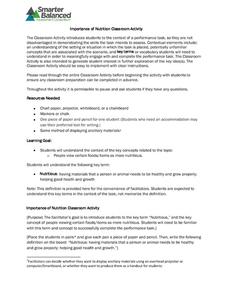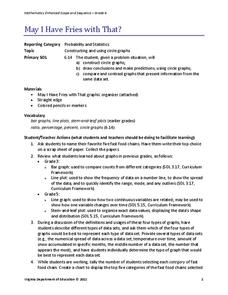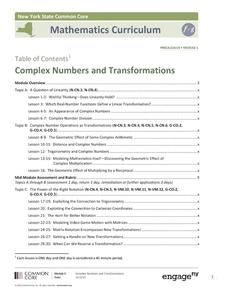Smarter Balanced
Importance of Nutrition
Prepare your class members for the performance task assessment on nutrition with an activity that asks class members to rank images of foods from least nutritious to most. Participants also offer reasons for why they ranked the...
Teach Engineering
Life Cycles
Breathe some life into product design. Pupils learn about the stages of product creation, use, and disposal—sometimes called a cradle-to-grave assessment. They see how this cycle relates to the life cycle of organisms.
State Bar of Texas
Marbury v. Madison
Who has the final say in matters dealing with the rules under the United States Constitution? The case Marbury v. Madison brings to light the issue of judicial review. Learners investigate the Supreme Court's opinion in the case with a...
Skyscraper Museum
Building a Skyscraper
Creating buildings that reach hundreds of feet into the sky is no easy task. The third instructional activity in this series begins with four activities that engage young architects in exploring the major challenges that are faced when...
National Security Agency
Classifying Triangles
Building on young mathematicians' prior knowledge of three-sided shapes, this lesson series explores the defining characteristics of different types of triangles. Starting with a shared reading of the children's book The Greedy...
Virginia Department of Education
May I Have Fries with That?
Not all pie graphs are about pies. The class conducts a survey on favorite fast food categories in a instructional activity on data representation. Pupils use the results to create a circle graph.
Common Sense Press
The Sign of the Beaver Vocabulary
A series of activities based on Elizabeth George Speare's The Sign of The Beaver takes your class through vocabulary, reading comprehension, and literary analysis. A good packet or collection of assignments for a reading circle.
British Counsil
Sport
From traditional sports like football and basketball to more unique or extreme sports like windsurfing, caving, or bungee jumping, your youngsters will surely get a thorough introduction to the world of sports with this lesson plan!
EngageNY
Construct a Perpendicular Bisector
How hard can it be to split something in half? Learners investigate how previously learned concepts from angle bisectors can be used to develop ways to construct perpendicular bisectors. The resource also covers constructing a...
Bowland
German or English?
Sprechen sie Deutsch? Future cryptographers must decide whether an unknown text is written in English or in German. They use provided pie charts about the frequency of words in the English and German languages to help make their decisions.
02 x 02 Worksheets
Inverse Functions
Young mathematicians look for patterns in inverse functions as they relate to the original functions. The comprehensive lesson emphasizes vocabulary throughout as well as algebraic and graphical characteristics of the inverse functions.
US Institute of Peace
Identifying Conflicts
When viewpoints collide, conflict arises. Can your pupils identify the components of conflict? The fourth in a series of 15 lessons about peacebuilding helps participants identify the underlying causes of conflict. Teams role play to...
Curated OER
Our Solar System
Learners analyze the theories of the formation of the universe and solar system. Students analyze planetary motion and the physical laws that explain that motion: Rotation, Revolution, Apparent diurnal motions of the stars, sun, and...
Curated OER
Dimensional Space: Various Perspectives
Learners use their understanding of 3D on 2D to make a representation of a 4D form on paper.
Curated OER
Buggy Patterns
First graders discuss the definition of patterns, and sing the song, Going Buggy, identifying patterns in the song. They create original patterns using bug counters and insect stickers.
Curated OER
Vocational: Fashion terms
Young scholars view a Powerpoint presentation on fashion industry vocabulary and locate examples in magazines that illustrate the terms. On black construction paper, students assemble collages of the magazine pictures representing each...
Curated OER
Airplane Wings
Students examine the aerodynamics of a wing and how it generates lift. In this flight lesson students complete several experiments including how to build a paper plane and how airfoils affect performance.
Curated OER
Vocabulary Bingo
Students review vocabulary words and definitions from a literature selection. They play Vocabulary Bingo to practice the words.
EngageNY
Complex Numbers and Transformations
Your learners combine their knowledge of real and imaginary numbers and matrices in an activity containing thirty lessons, two assessments (mid-module and end module), and their corresponding rubrics. Centered on complex numbers and...
Curated OER
Investigation - The M & M Mystery
Sixth graders inspect M&M's to complete statistical data. Students interpret percent of colors represented. They convert data from decimals, fractions, and percents. Using the data, 6th graders create a bar graph and a circle graph.
Washington State University
Defining Bullying
How can you recognize bullying? How is verbal bullying different from physical or social bullying, and when has a joke gone too far? Learners use their own experiences and ideas to inform the discussion.
Curated OER
Spacemobiles
Aspiring astronauts construct a space vehicle using cylinders, cones, spheres, and rectangular prisms. This is an engaging method of learning about three-dimensional shapes. Note that the word cylinder is constantly misspelled in the...
Curated OER
Rotational Inertia
Learners spin themselves to understand rotational inertia. In this Inertia activity, students will also use ramps, balance beam and pendelum to conduct rotational inertia experiments. Learners draw conclusions to explain rotational...
Curated OER
Finding Our Bonds: King Day
Students explore the concept of philanthropy. In this service learning lesson plan, students experience literature and participate in a simulation that examines discrimination, prejudice, and stereotypes.

























